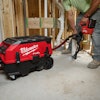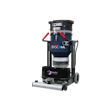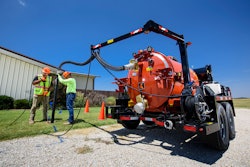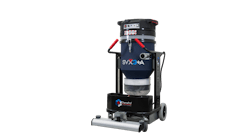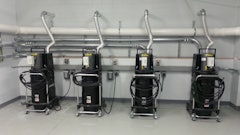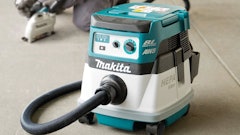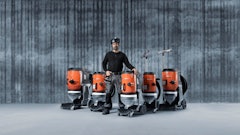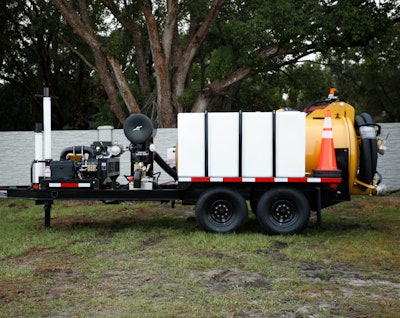
Considering adding a vacuum excavator to your rental fleet? It could be a great fit if your customer base includes utility contractors, municipalities, industrial maintenance professionals or specialty contractors.
Vacuum excavators combine suction and high-pressure water or air to remove soil from the ground. This soft digging method helps avoid damage to existing infrastructure, which makes vacuum excavators ideal machines for an evolving list of applications.
More than one type of professional is driving the demand for vacuum excavation equipment. Utility contractors are at the top of the list. They depend on vacuum excavators for potholing and controlling slurry during horizontal directional drilling (HDD) operations. However, municipalities and specialized contractors rely on vacuum excavators to clean storm drains and culverts, perform water line repairs and jet sewer line pipes when properly equipped. Other customers are discovering the benefits of the soft digging process in a wide array of applications.
Excavation for poles, footings for signs and fence posts have become common. Vacuum excavators excel in many digging tasks where either a small hole is required or there may be hidden infrastructure. In northern climates, it makes digging below the frost line less of a challenge.
Demand creates rental opportunity
Demand for HDD will continue well into the future as the fiber optic network is built out. This will drive a need for vacuum excavation equipment. At the same time, soft dig solutions continue to move mainstream, creating additional demand.
Utility contractors typically own their own vacuum excavation systems, but they often must deal with seasonal fluctuations in work volume and equipment availability. This creates an opportunity for rental stores to add vacuum excavators to the rental fleet. Projects located a long way from a utility contractor’s home base also create rental demand. This is due to equipment transport challenges. Trailer hitch space is at a premium.
Rental stores can include a vacuum excavator as part of the package when other equipment, such as mini excavators, are rented for a job. Some rental stores already realize the benefits of adding a vacuum excavator to their fleet.
Rental offers customers flexibility
In addition to transport issues and seasonal fluctuations in workflow, customers may have an interest in rental versus ownership to keep the equipment off the books. It allows the customer to pay a fixed price for use without having to purchase the unit.
With a wide growing customer base and an expanding list of applications, vacuum excavators can add a new dimension to your current rental fleet.
Deciding on a vacuum excavator
Once you make the decision to add a vacuum excavator to your rental fleet , the next step is to identify the most appropriate unit.
Vacuum excavation units are typically either mounted on trucks or trailers. The vast number of vac trucks on the market does put pressure on the rental rates you may be able to charge. However, the potential qualified customer base for truck rentals is smaller than for trailer-mounted vacuum excavators because truck vacs require an operator with a commercial driver's license.
Consider local conditions
Local ground conditions will have a large impact on vacuum excavator selection. Hose size and the volume of air being moved by the pump, typically referred to as vacuum cubic feet per minute/cubic meters per minute (CFM), help determine performance.
Many manufacturers offer different vacuum pumps in each hose size to tailor the machine to the application. For instance, a contractor who only needs to suction drill slurry would not need a high CFM model. It would be too much for the application. On the other hand, many contractors who are potholing will seek out a small-hosed, high CFM model. For larger-diameter hoses or longer hoses, more horsepower will be required.
Size the spoil tank
One of the major considerations when selecting units for a vacuum excavation fleet is sizing of the product tanks. Department of Transportation weight regulations and the distance to the dump site will play a role in product tank sizing. Larger spoil tanks will let you operate longer before having to head off to the dump site, keeping crews working on the site. The downside of the larger spoil tank is that the weight will require a larger truck. In some instances, a commercial driver's license might be required.
There are a few guidelines that can help determine the appropriate tank size. Trailers provide flexibility when trying to source a versatile solution for a rental vacuum excavation fleet that meets the needs of a wide variety of customers. Sizing these trailers is a matter of understanding the tradeoffs between tank capacity and transport requirements.
There are lighter-weight options available, as well. Many utility providers run 500-gallon spoil tanks. By contrast, the utility contractor wants more storage. There are larger tanks up to 1,200-gallon available for trailer-mounted vacuum excavators, but they tend to make the units big and heavy. As the projects grow even larger, the conversation might shift toward truck vacs. These machines may navigate the job site more efficiently.
Seek expert advice
When adding vacuum excavators to your rental fleet, there is no one-size-fits-all solution. Several criteria need to be considered including whether you need trucks or trailers, vacuum performance, tank size and applicable options. Each region of the country will have different requirements. To help you navigate to the best option, you should seek the advice of your local dealer.

